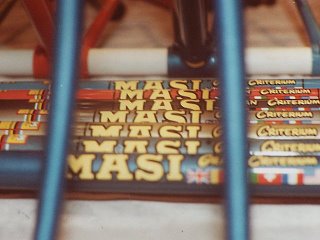Cyclist 'Sub-Species'
The University of Southern Oklahoma extension campus in downtown Broken Elbow, has released some startling information from a study of bicyclist characteristics. The Sociology Department studied various group bicycle rides to investigate the interpersonal dynamics that effect large groups. While the study itself is quite long, the summary details the fascinating personality types or, as the researchers dubbed them, 'sub-species' they identified. Like any pack or herd of animals, each type has a role to play in pack behavior, and if further funding can be secured, the university plans to do additional research next summer.
I've interspersed a few comments in italics.
Some highlights follow:
Gazellopes: Skinny wiry guys who make climbing hills, sprinting, and fast pack riding look so easy any idiot can do it. I hate them. On the other hand, female gazellopes are fascinating to watch, though their indulgent smile and superior attitude is somewhat irritating as they ride away from me up a hill. Come to think of it, I hate them too.
Thesaurosaur: A boring, talkative old fart who goes on and on about how things were so much better in his youth - unless it's ME going on and on about interesting, informative topics from MY youth. Thesaurosaurs are often spit out the back of a pack of Gazellopes, where they regale all and sundry with tales of how much better they used to be.
Rolling Thunderer: A large guy on a bike who ate something disagreeable for lunch. Always be aware of the wind direction when near a Rolling Thunderer.
Lone Horseman of the Apocalypse: Here's the guy who's ready for anything - especially if that turns out to be a post-nuclear wasteland inhabited by cannibalistic zombies. He's equipped to fix a flat tire or nearly anything else too. He carries every important bicycle tool ever invented by man, and a few he's invented himself. He clanks when he walks. Conversation revolves around gloom or doom, unless he's depressed, then it's gloom AND doom. He expects the worst and is mildly disappointed when doomsday is postponed yet again. Inside every dark, ominous cloud, the Lone Horseman finds a darker, more ominous one.
The Duke of Hurl: The guy who will toss his cookies in every time trial he enters, usually on an uphill section, and always right in front of you. Sometimes this leads to sympathetic hurling. Just like the rolling Thunderer, it's important to know the wind direction when passing the Duke.
Flesh-Eating Bambi: A sweet, innocent-appearing young woman with an inner tiger looking for a rich husband or a quick meal. Make no mistake, the Flesh-Eating Bambi is an uber-predator, luring its prey in close before killing it.
Euro-Suave: Known as both predator and prey of Flesh-Eating Bambis, the Euro-Suave sports the latest high-tech bike equipped with the latest high-tech gadgets. He wears this year's kit from a top ranked European racing team. He spends more on cologne than the rest of us spend on beer. Despite all that, Euro-Suaves are often found torn and bleeding on the roadside after an encounter with a Flesh-Eating Bambi, unless he happens to be a doctor or someone else with money. In that case, he'll be found on the roadside in a few years, torn and bleeding from his bank account.
Clueless Bumblerbees: Wandering from side to side, Clueless Bumblerbees have the attention span of a gnat. They're completely unaware of other cyclists, motor vehicles, potholes, or any other potential hazard. Instead, their attention is given to roadside flowers, birds, or cows, and they'll wander all over the road while other cyclists dodge their meandering path. Clueless Bumblerbees live in simpler, less stressful world, and I sometimes envy them for that. I do not envy their frequent crashes or the odd ambulance ride.
Pseudo-Cops: Remaining at the back of the pack, Pseudo-Cops will yell, "Car back! Car back! Car back!" with each shout becoming louder and more shrill, until only dogs can hear them. Their expectation is that the rest of the group will form a single file riding on the fog line. Simply ignoring Pseudo-Cops ruins their day - not that I'd do that, of course.
Chicken Little Hans: Sigmund Freud did a case study of a patient he called "Little Hans". Hans was afraid of many things, but was especially disturbed by horses. In the same vein, Chicken Little Hans is afraid of nearly everything to do with riding a bicycle and insists that the roads are far too dangerous in their present state to permit safe bicycle travel. "The cars are coming! The cars are coming!" is a constant Chicken Little Hans refrain. He will not feel safe until he's given an entirely separate bicycle path system free of the motorists he hates and fears. Then Chicken Little Hans will be free to terrorize pedestrians in the same manner as motorists have terrorized him.
Mister Clean: With an absolutely pristine bicycle, Mr. Clean finds little time to actually ride. In order to keep his machine spotless, he will not ride in the rain, or when it's threatening to rain sometime in the near future. He will not ride on damp streets, and recoils in horror at the idea of riding along a dirt road or even on one that's rough and pebbly. Pebbles can chip paint, you know.
Re-Tars: Not to be confused with the epithet 'retards', re-tars are those who use the same tires and tubes that came with their bike way back in the Pleistocene, or maybe the 1980s. They are polar opposites of Mister Clean. Their tires are lumpy with patches, so lumpy that any cyclist with a sense of self-preservation will not ride near them. The bikes squeak and squeal due to rusty chains, mis-aligned brakes, and cables that remain attached by a few stalwart threads. Re-Tars are often found in the company of the Lone Horseman of the Apocalypse to their mutual benefit.
Infectious Recumberent: Possibly a sub-species of the Thesaurosaurus, the Infectious Recumberent is known to talk endlessly about the advantages of his outlandish machine. He will spend an equally endless time talking about the international conspiracy to suppress recumberents. If you are in close proximity to Infectious Recumberents on a regular basis, it's strongly advised to get an innoculation of anti-Recumberent DNA in order to keep your sanity, if desired.
George Leroy Tirebiter: More commonly known as 'wheelsuckers', but university researchers felt the term was a mild epithet, and the substitute term - George etc. - was more neutral in tone. Cyclists dogged by a persistent wheelsucker who will not take a turn at the front have no hesitation in using more colorful and far less neutral terms to describe them.







